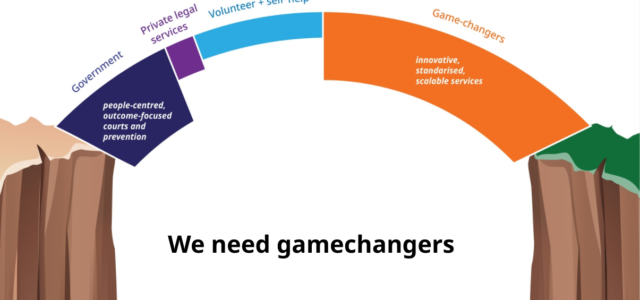What factors and characteristics contribute to justice innovation? How can existing justice services improve their models to increase access to justice? How can the private sector and public sector support and innovate people-centred justice?

HiiL tackled these questions with three expert-led working groups. Each working group was charged with examining the critical success factors for realising effective justice services. The sessions focused on three gamechanger categories: Community Justice Services, User-friendly Contracts and One Stop Shop Dispute Resolution.
On 23 March, we published the insights and findings in policy briefs during a live webinar.
“This is about focusing on the users and empowering them to develop the best possible solutions for everyday justice problems,” said Kanan Dhru, Justice Innovation Advisor at HiiL.

Community Justice Services
Community justice services seem to be an indispensable element of a justice system that provides equal access to justice for all. Gradually, policymakers are discovering how to scale the programmes at regional and country levels. This policy brief lists a number of critical success factors that HiiL developed with insights from leading experts in the field. The five factors essential to scaling community justice services are:
- Standardising working methods of the community justice service.
- Monitoring the outcomes delivered to people.
- Combining the strengths of informal justice and rights-based dispute resolution.
- Making community justice services affordable and financially sustainable.
- Building scale from the ground up.
“Drawing on the collective experience of HiiL and our working group experts, we also identified examples of services that have already been scaled or are internationally recognised for their quality of services,” said Manasi Nikam, Knowledge Management Officer at HiiL.
Of course, this is only an overview of our policy brief. To learn more about each critical success factor as well as the examples of community justice services, please refer to the full policy brief.

User-friendly Contracts
Contracts are essential tools for enabling cooperation between people. Although legal professionals are comfortable with such documents, most people find contracts difficult to understand. However, a growing group of scholars and innovators are making contracting a more positive experience. These Gamechangers are developing user-friendly contracts that are fair and transparent and help people to better understand their rights and obligations.
The five factors essential to scaling user-friendly contracts are:
- Optimising user experience.
- Showing and optimising the benefits for client companies.
- Changing the mindset of lawyers and companies on contracting.
- Developing a financially sustainable model.
- Establishing a supportive regulatory environment.

One-Stop-Shop Dispute Resolution
One-stop-shop dispute resolution systems humanise legal procedures by giving people more control over how their disputes will be addressed and resolved. Subsequently, many courts now operate online dispute resolution modules, however, few examples of large scale implementation exist. In this policy brief, we detail the following critical success factors to help scale OSSDR systems.
- Having a User-centred design of the dispute resolution procedure and system.
- Solving the ‘Submission Problem’: Getting the other disputing party to the table.
- Monitoring outcomes that the system provides to people.
- Forming effective public-private partnerships.
- The government opening the regulatory doors to stimulate different types of initiatives.
- Having a sustainable revenue model.
“When we talk about Gamechangers, we’re not talking about blockchain or automated judgements,” said Maurits Barendrecht, HiiL’s Director of Research & Development. “Instead, we get a glimpse into the next generation of services and these are about community justice, next-generation courts, and next-generation contracts. They focus on people and their needs and relationships.”
Watch or re-watch the full webinar:




